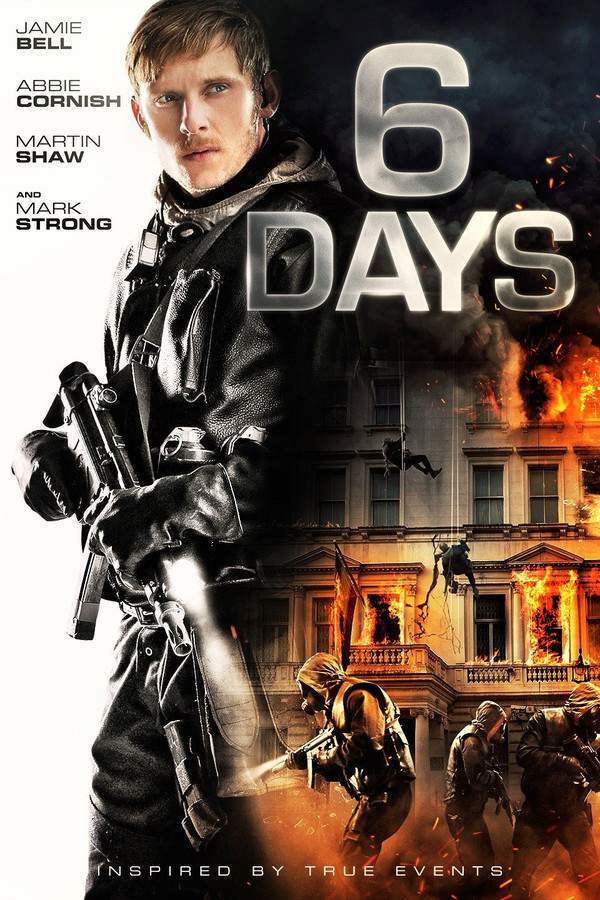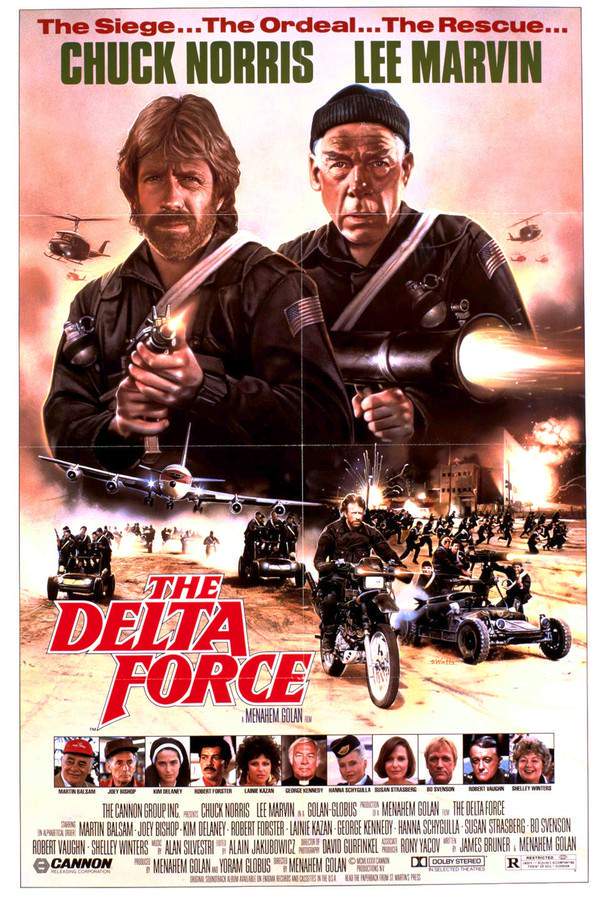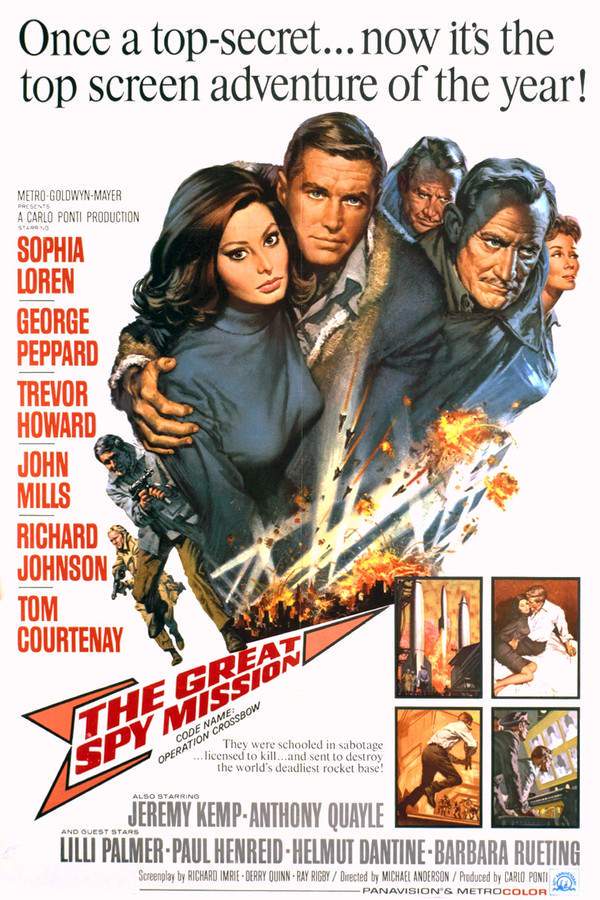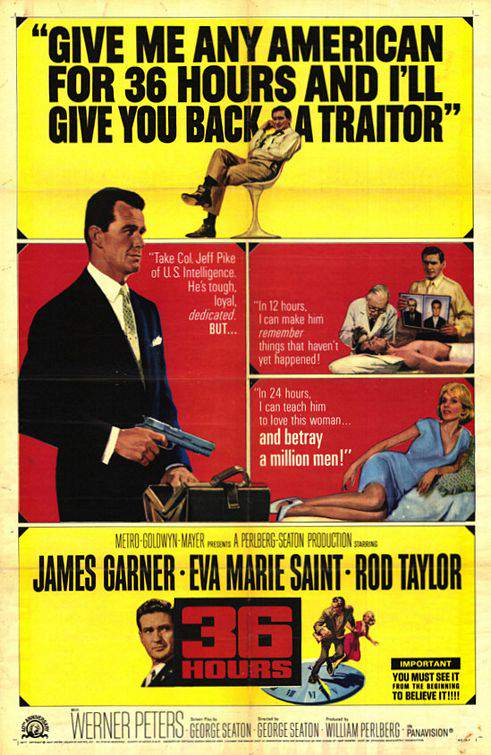
6 Days 2017
Directed by

Toa Fraser
Made by

Vertical Entertainment
Test your knowledge of 6 Days with our quiz!
6 Days Plot Summary
Read the complete plot summary and ending explained for 6 Days (2017). From turning points to emotional moments, uncover what really happened and why it matters.
International terrorism surged during the 1970s, with each attack prompting a familiar pattern of negotiations and compromises, which only served to give more legitimacy to the terrorists’ actions. The ramifications of a recent, failed mission by US special forces to free 52 American captives in Iran loomed large as Margaret Thatcher took office in the UK.
On 30 April 1980, a group of six Iranians, led by Salim, seized control of the Iranian Embassy at 16 Princes Gate, Kensington, London, taking at least 25 hostages in the process. This incident garnered the attention of significant figures including Lance Corporal Rusty Firmin from the SAS (Special Air Service), Kate Adie, a BBC reporter, her cameraman Bill, and Chief Inspector Max Vernon of the Metropolitan Police, who assumed the role of chief negotiator positioned seven doors from the embassy. The area was quickly cordoned off as tension escalated.
The terrorists, identifying as the Democratic Revolutionary Front for the Liberation of Arabistan, issued a chilling ultimatum over the phone: the release of 91 Arab prisoners in Iran, or a hostage would die by noon the next day if their demands were ignored. The Iranian government steadfastly refused to comply, leaving the UK Government to weigh the options between negotiation and the use of force.
The Home Secretary, William Whitelaw, 1st Viscount Whitelaw, was informed by Thatcher that the full extent of British law was to be applied in this crisis. On the first night, Max found himself in a challenging position, conversing with Salim while trying to discourage violence. He explained the difficult diplomatic landscape, stressing that Britain had minimal influence over Iran. As the terrorist threat escalated, Max managed to avert a premature assault by the SAS forces, which were prepared to intervene should a hostage be harmed.
During one of his negotiations, Salim released a hostage due to illness but remained firm on his threat to start executing the others unless their demands were met. After delivering food to the terrorists, Max learned that Salim was demanding two buses to Heathrow Airport, buying some time to meet this demand. Meanwhile, the SAS leveraged the extra 48 hours to gather intelligence on the embassy layout, discovering that the terrorists were heavily armed with Soviet-era grenades.
Planning was tense as the SAS contemplated a direct approach, with strategies discussed to infiltrate the embassy through the skylight during the night. However, these plans were put aside as the British government deemed them too risky.
As the situation drew on, Salim continued to make threats, resulting in increasing pressure on the authorities. When another hostage was fatally shot after demands were unmet, the SAS prepared to act decisively. Rusty and his team coordinated an intricate maneuver to keep Salim engaged on the line while they executed their plan.
On Day 6, the tension reached a boiling point as Faisal, Salim’s right-hand man, killed a hostage after the bus demand was again unmet. Rusty took this opportunity, and with proper distraction from Max, the SAS stormed the embassy. They successfully freed the hostages and neutralized the terrorists, including Salim, during a fierce gunfight.
Thatcher’s decision to deploy the SAS during this crisis is viewed as a pivotal moment in counter-terrorism, setting a precedent for how governments respond to similar situations in the future.
6 Days Timeline
Follow the complete movie timeline of 6 Days (2017) with every major event in chronological order. Great for understanding complex plots and story progression.
Surge of International Terrorism
The film opens with a depiction of the surge in international terrorism throughout the 1970s. Each unsuccessful mission and subsequent negotiation only legitimized terrorist actions in the eyes of public and political powers.
Margaret Thatcher Takes Office
As Margaret Thatcher assumes the role of Prime Minister in the UK, the ramifications of a recent failed mission to free Americans in Iran loom large. This sets a tense backdrop for the crisis that unfolds.
Iranian Embassy Seizure
On April 30, 1980, six Iranians led by Salim seize control of the Iranian Embassy in London. They take 25 hostages, sparking immediate media attention and a swift response from authorities.
Initial Negotiations
Notable figures, including SAS member Rusty Firmin and negotiator Chief Inspector Max Vernon, quickly converge on the scene. The area surrounding the embassy is cordoned off as tension escalates, with police and media in close proximity.
Terrorists' Ultimatum
The terrorists, identifying as the Democratic Revolutionary Front for the Liberation of Arabistan, issue an ultimatum for the release of 91 Arab prisoners. They threaten to kill hostages if their demands are not met by the following noon.
Government Decision-Making
In response to the escalating threats, Home Secretary William Whitelaw is informed that the UK government must apply full legal measures. This decision marks the beginning of a delicate balance between diplomacy and potential force.
Max's Negotiations with Salim
Max Vernon finds himself negotiating with Salim, trying to mitigate violence while explaining Britain’s limited influence over Iran. His efforts are crucial as the situation veers towards a violent eruption.
Release of a Hostage
During the negotiations, Salim releases one hostage due to illness, showcasing a fleeting moment of humanity amidst the tension. However, he remains resolute in his threat to execute others if demands are not fulfilled.
SAS Intelligence Gathering
With the deadline approaching, the SAS uses the additional time from the hostage release to gather critical intelligence on the embassy. They learn that the terrorists are heavily armed, prompting concerns over the safety of the hostages.
Contemplating Force
The SAS devises a plan to storm the embassy via the skylight. However, the British government deems these plans too risky, resulting in heightened anxiety among command.
Escalating Threats
As time passes, the urgency increases when another hostage is killed after demands go unmet. The situation becomes critical, compelling the SAS to prepare for intervention, as public and governmental pressure mounts.
The Day of Reckoning
On Day 6, tensions explode as Faisal, Salim's subordinate, murders a hostage after further demands are ignored. This incident triggers an immediate response from the SAS, marking a crucial turning point in the operation.
SAS Storms the Embassy
In a calculated move, Rusty and his team enable a diversion that allows the SAS to storm the embassy. Amidst a fierce gunfight, they successfully free the hostages and neutralize the terrorists, including Salim.
Thatcher's Pivotal Decision
Thatcher's choice to deploy the SAS during this hostage crisis is seen as a defining moment in counter-terrorism strategy. This event shapes the future responses of governments around the world to similar terrorist threats.
6 Days Characters
Explore all characters from 6 Days (2017). Get detailed profiles with their roles, arcs, and key relationships explained.
Salim (Ben Turner)
Salim is a determined and cold-blooded leader of the terrorists who orchestrates the hostage crisis. His ruthless demeanor is matched by his strategic mind, as he takes advantage of the situation to exert pressure on the British government. Salim's character embodies the darker aspects of human nature driven by ideological fervor and desperation.
Lance Corporal Rusty Firmin (Jamie Bell)
Lance Corporal Rusty Firmin is a resourceful and courageous member of the SAS. His character embodies bravery and a commitment to protect the hostages, working under pressure to devise a rescue plan. Rusty's tactical skills and quick thinking prove essential as he navigates a volatile environment filled with uncertainty and danger.
Chief Inspector Max Vernon (Mark Strong)
Chief Inspector Max Vernon is the chief negotiator tasked with managing the crisis. He is calm under pressure and utilizes his negotiation skills to diffuse the situation and secure the safety of the hostages. His character highlights the challenges of balancing authority and empathy in high-stakes negotiations.
Kate Adie (Abbie Cornish)
Kate Adie is a determined BBC reporter on the scene, providing insight into the media's role during crises. Her character represents the pursuit of truth and the complexities of reporting in dangerous situations. Kate's presence emphasizes the public interest in the unfolding drama and the pressure it puts on the authorities.
6 Days Settings
Learn where and when 6 Days (2017) takes place. Explore the film’s settings, era, and how they shape the narrative.
Time period
1980s
The 1980s marked a critical period in global politics, characterized by heightened tension surrounding international terrorism. Following significant events such as the Iranian Revolution and geopolitical shifts following the Cold War, countries faced the complex challenge of addressing rapidly evolving threats while navigating diplomatic relations and public safety.
Location
Iranian Embassy, Kensington, London
The Iranian Embassy in Kensington, London, became the center of a tense hostage situation in 1980. This historic building is known for its architectural significance and is situated in a prominent area, often bustling with activity. The location's high-profile nature drew intense media coverage and government scrutiny during the crisis.
6 Days Themes
Discover the main themes in 6 Days (2017). Analyze the deeper meanings, emotional layers, and social commentary behind the film.
🕊️
Terrorism
The theme of terrorism is central to '6 Days,' highlighting the impact of extremist actions on innocent lives. The film explores how governments negotiate with terrorists in high-stakes situations, often leading to moral dilemmas and complex decisions. It reflects on the evolving landscape of counter-terrorism strategies and the human cost of such conflicts.
🤝
Negotiation
Negotiation plays a pivotal role in the film as characters attempt to avert violence through dialogue. The delicate balance between yielding to demands and maintaining authority is crucial in the narrative, showcasing the stakes involved in hostage situations. The negotiations signify hope and strategy amid chaos, portraying the complexities of human interaction in crisis.
⚔️
Crisis Response
The film examines the theme of crisis response, particularly the decision-making processes of government officials during emergencies. With a focus on the SAS's tactical deployment, it sheds light on the intricacies of planning and action under pressure. The portrayal of these strategies offers insight into how law enforcement evolves in response to contemporary threats.

Coming soon on iOS and Android
The Plot Explained Mobile App
From blockbusters to hidden gems — dive into movie stories anytime, anywhere. Save your favorites, discover plots faster, and never miss a twist again.
Sign up to be the first to know when we launch. Your email stays private — always.
6 Days Spoiler-Free Summary
Discover the spoiler-free summary of 6 Days (2017). Get a concise overview without any spoilers.
In the spring of 1980, the heart of London becomes a stage for a high‑stakes confrontation that reverberates far beyond the city’s streets. A sudden seizure of the Iranian Embassy ignites a volatile standoff, drawing the eyes of governments, the media, and an anxious public. The episode unfolds against a backdrop of Cold War tension and a burgeoning awareness of international terrorism, creating an atmosphere where every decision feels like a precarious balance between diplomatic restraint and decisive action. The city’s iconic architecture and the cramped, watchful corridors of the embassy amplify the claustrophobic sense of urgency that pulses through every moment.
Lance Corporal Rusty Firmin arrives as the spearhead of the elite Special Air Service, a unit accustomed to operating in the shadows of politics and war. Across the street, Chief Inspector Max Vernon assumes the role of chief negotiator, navigating the thin line between empathy and pressure as he converses with the hostage‑takers. Meanwhile, Kate Adie, a determined BBC reporter, moves through the cordoned zone with a camera crew, striving to capture the human drama unfolding behind the barricades. Their intersecting paths—a disciplined soldier, a seasoned police officer, and an inquisitive journalist—highlight contrasting approaches to crisis, each wrestling with personal convictions and the weight of public expectation.
The film hovers in a tone that mixes sober realism with a quiet, mounting dread, letting the audience feel the relentless ticking of a clock that cannot be stopped. As intelligence gathers and strategies are debated behind closed doors, the SAS team prepares a meticulous operation that promises to test the limits of skill, courage, and resolve. The stakes are amplified by the global spotlight, leaving viewers aware that every whispered negotiation and measured footstep could tip the balance between catastrophe and salvation.
Can’t find your movie? Request a summary here.
Movies with Similar Twists and Themes
Uncover films that echo the narrative beats, emotional arcs, or dramatic twists of the one you're exploring. These recommendations are handpicked based on story depth, thematic resonance, and spoiler-worthy moments — perfect for fans who crave more of the same intrigue.
Featured on this page

What's After the Movie?
Not sure whether to stay after the credits? Find out!
Explore Our Movie Platform
New Movie Releases (2026)
Famous Movie Actors
Top Film Production Studios
Movie Plot Summaries & Endings
Major Movie Awards & Winners
Best Concert Films & Music Documentaries
Movie Collections and Curated Lists
© 2026 What's After the Movie. All rights reserved.












